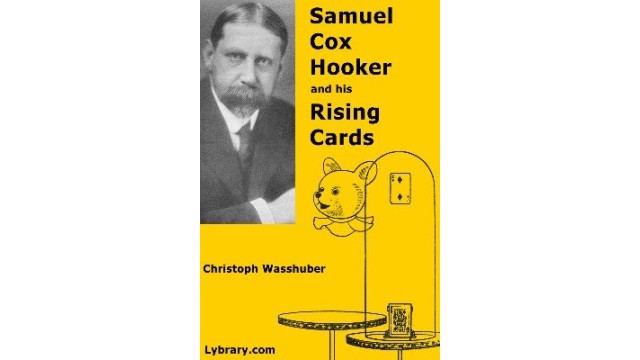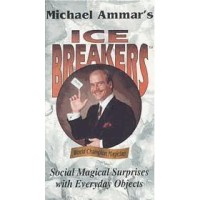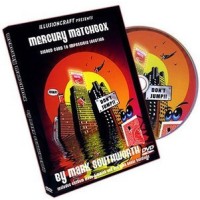Samuel Cox Hooker And His Rising Cards by Chris Wasshuber
- Product Code: C#20052
- Reward Points: 20
- Availability: In Stock
- $13.99
-
$4.99
- Price in reward points: 499
Dr. Samuel Cox Hooker's Rising Cards have been an unexplainable fascination for nearly a century. Hooker first showed his effect in 1914, and in 1993 and 2007 John Gaughan gave abbreviated performances. Nobody who has seen the Hooker Rising Cards performed has ever been able to explain how such effects can be accomplished. This includes the most notable and most knowledgeable magicians from past and present. How can, from a borrowed and shuffled deck, any card called for rise in the fairest possible manner on a well lit stage only a few feet from the spectators?
This work is not just about how I think Hooker achieved these incredible effects, but about a fascinating man and the fascinating history of rising card apparatus. Samuel Cox Hooker and his Rising Cards will first examine three famous card rising apparatus: the Hofzinser card automaton, the Neyhart houlette, and Joseffy's rising cards. It then examines Hooker the person covering his private, scientific, and magic achievements.
This is followed by two theories of how the Hooker Rising Cards could be done. The first theory was purely based on my conclusions studying the historical record and is most likely not how it is done. The second theory arose from observations brought to me by individuals who have seen one of the 2007 reenactments and it can exactly replicate a core set of effects. I built a Lego prototype to prove that this mechanism works, is practical and indeed replicates the effects precisely. You will be able to see photos of the prototype and read a detailed description of it.
I have studied the historical records, I have extensively communicated with people who have seen Gaughan's reenactments in 1993 and 2007 and I have thought for countless of hours, pieced together clues, and applied my own understanding of magic methods and technology. However, it is not possible for me to say that one of my methods is 'the' method used by Hooker, but I have proven it is at least 'a' method. Potentially it is even a more practical method than the original method.
Samuel Hooker created his rising cards to stimulate magicians to think and come up with their own solutions and explanations and through that process of inquiry, to develop new methods and techniques. As a scientist this is a very natural way of learning. Nature exposes us to all kinds of mysteries, questions, and puzzles and scientists try to explain them. They conduct experiments and think logically about them to advance their understanding of nature. Fundamentally scientists are driven by nature's secrets and want to understand and explain them. In the same way Hooker is presenting magicians with a mystery and he is asking us to think about ways how it could be done. Hooker himself solicited explanations from his spectators. This work is my answer to Hooker's solicitation.
This publication was written with this very spirit in mind. Perhaps it stimulates others to also think hard about new ways to achieve such effects. I have communicated with other magicians, some of them notable and recognized, who have developed their own theories about how Hooker did it. This lead to exciting and stimulating exchanges of ideas and critiques - exactly the kind of effect Hooker wanted to achieve with his "Impossibilities".
(For a short biographical sketch published in a Google map click here.)
At the end of the book you will find a chronological record and reproductions of many articles and letters, including unpublished records, related to Samuel Hooker. This makes for fascinating reading regardless of if you agree with my theories or not.
[Please keep in mind that the book and ebook differ in the following way: All photos and illustrations which are color in the ebook are in b/w in the book. The book has been reformatted to a smaller form factor 6'' x 9''. Should I have the time to release a video of my prototype, then such a video will only be part of the ebook, not the book.]
- Contents
- Acknowledgment
- Introduction
- Other Famous Any Card Rises
- - Hofzinser
- - Neyhart
- - Joseffy
- Hooker the Person
- How Could it be Done? (theory #1 - probably not)
- - Hooker's idea
- - Boundary conditions
- - Fundamental method
- - Multiple methods for the same effect
- - Afterthoughts
- Card March
- How Could it be Done? (theory #2 - much better)
- People in the Know
- Chronological Source Documents
- 1913, July
- 1914, April
- 1915, June
- 1915, August
- 1916, January
- 1916, March
- 1917, July 6th
- 1917, September 25th
- 1918, January
- 1918, February
- 1918, February 16th
- 1918, March 16
- 1918, March 23
- 1918, April 20th
- 1918, May 11th
- 1918, September
- 1927
- 1929, April 10th
- 1929, April 20th
- 1929, April
- 1929, April
- 1929, June
- 1929, June 10th
- 1929, November
- Undated
- 1934
- 1935, January
- 1935, October 14th
- 1935, November
- 1936
- 1936, June 19th
- 1936, September
- 1936, November
- 1937, June
- 1937, July
- 1937, August
- 1939, January
- 1944
- Undated
- 1945, July
- 1947, June
- 1949, April
- 1949, April
- 1949, June
- 1951, August
- 1955, February
- 1966, July 5th
- 1966, June
- 1966, October
- 1967, April (John Mulholland in Pallbearers Review and Magic Circular)
- 1970, July
- 1976
- 1993
- 1993, November, 6th (Gene Matsuura's personal notes)
- 1994, January
- 1994, January (Bill Miesel in Precursor)
- 1994, April
- 1994, May 9th
- 1995 (John Booth in Fine Art of Hocus Pocus)
- 2007
- 2007, November 9th
- 2007, December
- 2008, January
- About the Author
- About the Publisher
word count: 55341 which is equivalent to 221 standard pages of text
Reviews (0)
Related Products
Sticks & Stones (1-6) by Jon Racherbaumer
Jon Racherbaumer - Sticks & Stones Vol 1 -. 6PDFNo. 1, January 19771 Subconscious (Edward Marlo)..
$2.99 $8.69
M.I.N.T. Volume 2 by Edward Marlo
The legendary cardician of this century, Edward Marlo, provided magicians with more card miracles an..
$3.99 $9.99
M.I.N.T. Volume 1 by Edward Marlo
M.I.N.T. Volume 1by Edward Marlo is the first in a series recounting nearly a quarter century of out..
$3.99 $9.99
Tarbell 27 Rising Cards by Dan Harlan
Dan Harlan - Tarbell 27 Rising CardsEffect of presentation: http://www.penguinmagic.com/p/5508Causin..
$1.99 $4.99
Tarbell 95 Magic With Cards by Dan Harlan
Slippery Aces: A classic ace assembly using a simple sleight that lets you vanish the aces in a..
$2.99 $5.99
Recommend
Original Dream Fly by Michael Afshin
Michael Afshin - Original Dream Fly Original Dream Fly - If a magician walked up to ..
$1.99 $4.99
New Animations by Michael A. Ching
Michael A. Ching - New Animations: The Dancing Hankerchief BookPDFThis incredibly thorough publicati..
$2.99 $6.68
Icebreakers by Micael Ammar
Micael Ammar - Icebreakers 12 magic magic effect! This is a classic magic set of information anyt..
$1.99 $4.99
Southworth by Mercury Matchbox
Matchbox Southworth - Mercury Demonstration:Http://www.emagictricks.co.uk/demo/final_mercury...
$1.99 $4.99
Mentaljd Absolutely Mind Me Just Tell You ( Mandarin Chinese )
Liangsong Yan MentalJD absolutely mind me just tell you ( Mandarin Chinese ) Check audiences cards..
$1.99 $4.48
Icoin ( Mandarin Chines by Mentaljd Absolute Heart Muscle Reading
Liangsong Yan MentalJD absolute heart muscle Reading & icoin ( Mandarin Chinese ) Just like th..
$1.99 $4.48
Think Of Any Card by Mentaljd
MentalJD - Think Of Any Card ( Mandarin Chinese ) This is not just an effect, you can learn a po..
$1.99 $4.48
Pps by Mentaljd
MentalJD - PPS fast potent mind-reading systems ( Mandarin Chinese ) was kind enough to sh..
$1.99 $4.48
Mentaljddd by Mentaljd
Liangsong Yan graphic copy MentalJD - MentalJDDD ( Mandarin Chinese ) MentalJD of , MentalJDDD gr..
$1.99 $4.48
Mental P by Mentaljd
MentalJD - Mental P ( Mandarin Chinese ) Every time John was not only just a professor teaching ..
$1.99 $4.48
Psychic Hotline by Mentalist Mike Kempner
A spectator names any card in the pack (yes, it can literally be ANY card), and she calls up a mind-..
$2.99 $6.78
Feelings by Mentalbuster
MentalBuster - Feelings 2010 new soul magic props , can show a lot of strong , deeply loved magi..
$1.99 $4.99
Menny Lindenfeld Penguin Live Online Lecture
Site lectures Penguin Live Online Lecture - Menny Lindenfeld "Your structure of drama was very str..
$1.99 $4.68
Self Bending Paperclip by Menny Lindenfeld
Menny Lindenfeld - Self Bending Paperclip ( required specific props fit) METALISM Episode |..
$1.99 $4.99
Sealed by Menny Lindenfeld
Menny Lindenfeld - Sealed Demonstration effect :http://www.penguinmagic.com/p/4899 Perform INSANELY..
$1.99 $4.99
Mind Over Metal by Menny Lindenfeld
Menny Lindenfeld - Mind Over Metal We have seen the most visual bent spoon. Powerful and practica..
$1.69 $3.98


-by-Jon-Racherbaumer-160x90.jpg)








-200x200.jpg)










